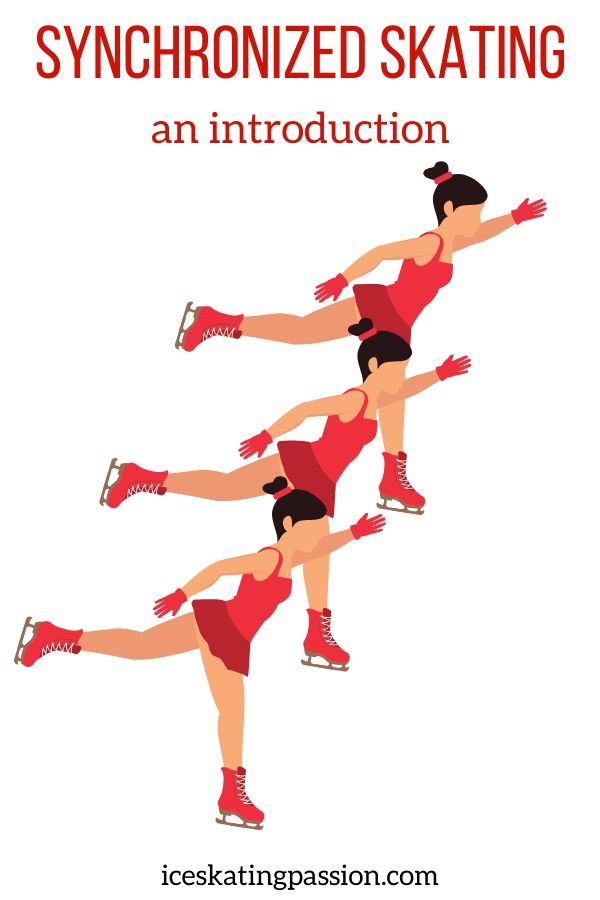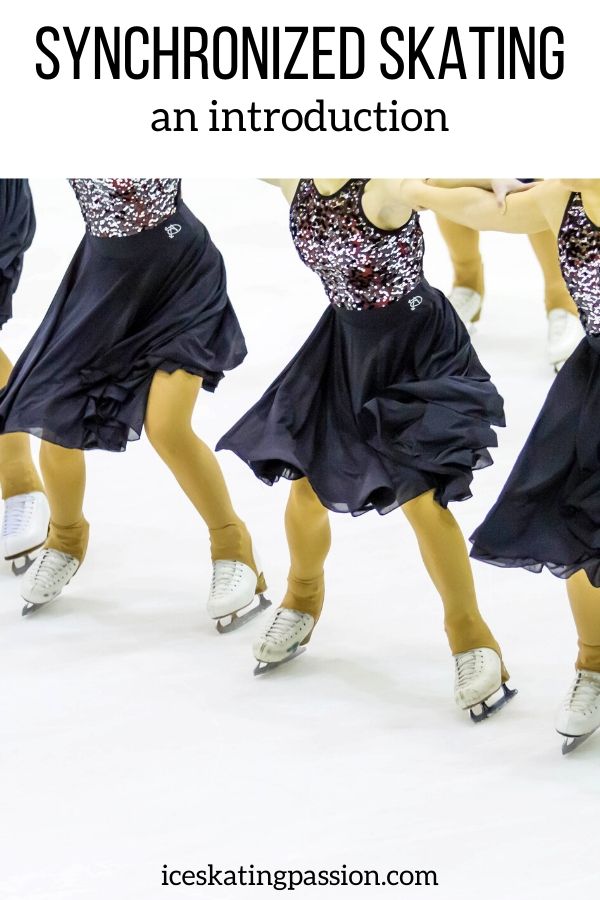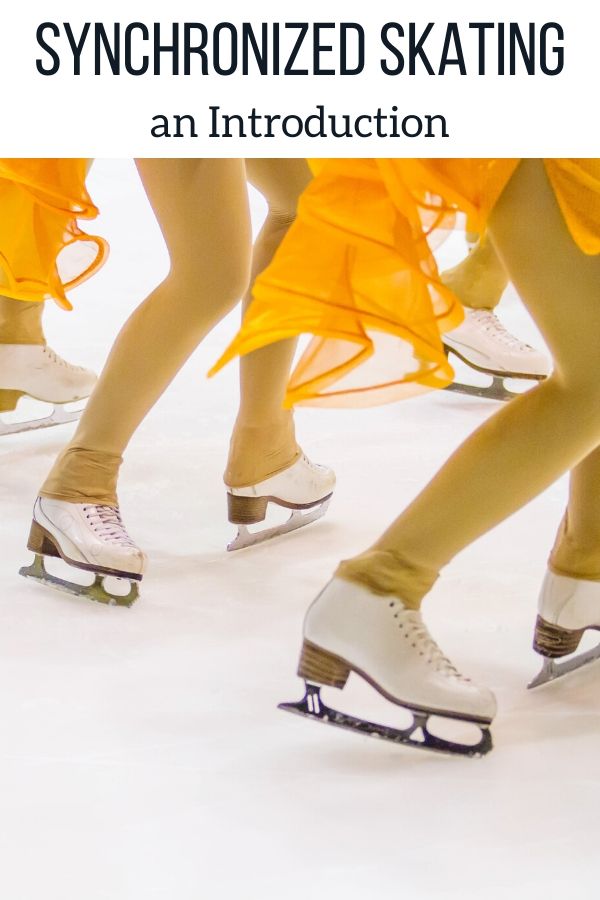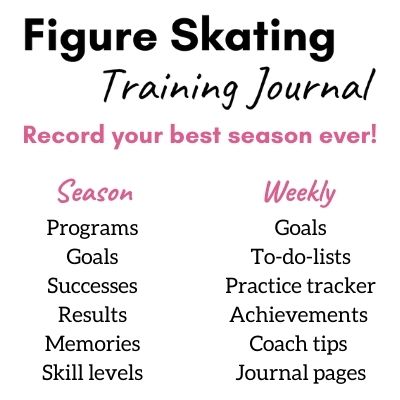Below is an introduction article to give you a brief answer to: What is synchronized skating? It covers a little bit of the history, how it is skated, the rules, the equipment and how to get started.
This article contains affiliate links. If you purchase using my link, I get a commission at no extra cost to you (learn more).
What is synchronized skating? Introduction
Synchronized skating is a team sport where 8 to 20 figure skaters (depending on the level) perform a program together on a traditional rink. They must move as a flowing unit doing technical footwork while skating at high speed.
It is often simply called "synchro".
It is a great way to combine the pleasures of figure skating with the benefits of participating in a team sport.
This sport has grown in popularity very fast, especially in the United states. Team members come from both figure skating and ice dance.
The competitions use the same judging system as traditional figure skating disciplines: all teams perform a free skate with required elements, and junior- and senior-level teams also perform a short program.
It is one of the official ice skating disciplines from the ISU (International Skating Union)
Brief history from precision skating
From precision skating... to synchro
In 1956, according to Wikipedia, the first team was started by Dr. Richard Porter in Ann Harbor, Michigan. They were called the Hockettes and the sport was then called Precision skating. It is known as the official start of the Synchro sport. But the Oxford Skating Society in England mentions that skaters were participating in groups of up to twelve skaters in "combined figure skating" events as early as 1838.
In the 1970s the sport developed, and the team movements became more and more evolved. And with more speed.
The first competition took place in 1976 between Canadian and American teams.
The sport then became international and skills were increased and clarified: jumps, spins and lifts were authorized, technical skating skills developed, and speed increased.
In the 1980s, sanctioned championships started in Canada and then the USA. And the sport grew overseas.
In 1994, the ISU recognized Precision team skating as a discipline of figure skating and sanctioned the first international competitions (with 15 countries participating).
In 1998, the ISU officially used the internationally recognized term "synchronized skating".
In 2000, the first World synchronized skating championship were held in Minneapolis with 21 teams from 17 countries.
Can it be an Olympic sport?
Today, synchronized skating has been reviewed for Olympic eligibility, but it is not an Olympic sport.
Although it is growing very fast, synchro may never be part of the Olympics because:
- The teams are huge - 20 skaters each which means high accommodation costs
- It is difficult to televise: you don't realize the speed and difficulty via a screen
- It is not popular is many parts of the World which limits the potential audience
- There are not enough countries with teams when the Olympics is a contest between all nations around the world - at senior level, only around 20 countries have teams today
Skates and equipment for Synchro
No extra tools have been invested to be able to join synchronized skating.
What the skater needs is pretty classic
Figure skates
Ice skates for synchro are typical figure skates. There is no particular requirement.
Typical ice skating equipment for training
The skater also needs the classic skating equipment such as blade guards, absorbent towel, blade soakers, a skating bag...
Check out my complete article about the essential figure skating equipment.
Team costumes
Of course, for competitions, tests and shows the skater needs to wear the team costume as the plan is to project unison.
New costumes are required each year for new programs
Basic rules & technical elements
The rink
There is the same ice rink requirement for synchronized skating as for the other disciplines of figure skating.
The Olympic size figure skating rink is 60m by 30m (196ft 10 inches by 98 feet 5 inches).
But in many towns, the practice rinks are a little smaller (56m x 26m).
The goal
The goal of a synchro team is to perform routines with:
- technical step sequences,
- intricate formations (isolated or holding)
- speed
- unison
Required elements (list varies based on level) include:
- No Hold Elements: footwork performed in unison when skaters are not connected. The block must remain aligned. Points increased for alignment stability and difficulty of the steps
- Pairs Elements: technical elements when 2 skaters hold one another such as step sequences, spirals, lifts, spins
- Wheels: to perform a wheel every skater must rotate around a common center point. There are different shapes of wheel possible (number of arms for example) and points increase with the difficulty of the step sequence.
- Blocks: step sequences performed in 3 to 5 parallel lines which should be straight and evenly spaced. Points increase for alignment, step difficulty, pivots, changes in direction or in configuration.
- Circles: any formation in the shape of circles (one or multiple, interlocked, disconnected...). Extra points are given when the circles are traveling while maintaining the shape.
- Intersections: when skaters move towards each other in lines and intersect. Extra points for the difficulty of the intersections: angle, turns, whip
- Lines: so many options here...
- Moves in the Field: sequence of movements with at least 3 different free skating moves (spirals, spread eagles, Ina Bauers...) and linking steps
How to start
1. Learning to skate
First thing first.
Before trying to skate attached to other people, you need to learn to skate on your own.
Synchronized skaters normally start with figure skating or ice dancing classes.
2. Reaching technical minimums for the team
Not all clubs have synchro teams.
If there are synchro teams with different levels at the rink where you skater practices, he/she can join the team when minimum skating level is reached.
3. Learning teamwork
Contrary to the other figure skating disciplines, synchronized skating adds another benefit to the sport of ice skating: learning team work, working together towards a common goal.
Levels & competitions in synchronized skating
Levels in the US
In the US, the synchronized skating teams can compete in 14 levels depending on age and skill level of the members:
Preliminary, Pre-juvenile, Open Juvenile, Juvenile, Intermediate, Novice, Junior, Senior, Open Collegiate, Collegiate, Adult, Open Adult, Open Masters, and Masters.
The 2 main competitive levels (with short and free programs) are:
- Junior - 12 to 16 skaters aged 12 to 18 - but check the applicable rules for the year / competition - 16 skaters may be required
- Senior - 16 skaters who are at least 15
How is synchro judged
For the competitive levels, the teams perform programs with required elements as listed earlier in this article (circles, intersections, no holds, blocks, wheels...). For Juniors and Seniors, the teams have to perform 2 programs (short program - 2min50 long and free skate 4min long for juniors and 4min30 long for seniors).
The judges will rate according to the International Skating Union system based on:
- skating skills - technical difficulty in the steps
- team skills - technical difficulty in the overall team movements including transitions
- unison
- speed
- dance interpretation
Technical Element score - Points are added this way:
- Each element has been assigned a difficulty level by a technical panel. It has a pre-determined base value.
- For each performance, judges assign a grade of execution (GOE) from -3 to +3 to each of the elements
- For each element, the highest and lowest GOE values are removed - the remaining GOEs are averaged and added to the base value.
- The sum of those scores make the technical element score
Program component score. Point are added this way:
- Each judge gives a mark between 0.00 and 10.00 (with 0.25 increments) for the following 5 components: skating skills, transitions, performance/execution, choreography, and interpretation
- The highest and lowest are removed and the mean is calculated
- Factors are applied
- The scores are added to make the Program component scores
Both scores are added, and the team with the highest score wins.
Some competitions may still use the older rating system with a range from 0.0 to 6.0.
Famous synchro teams
The sport is dominated by 5 countries: Russia, Finland, Sweden, USA, and Canada.
Some of the most titled teams at Senior level are:
- Team Paradise from Russia
- Marigold IceUnity from Finland
- The Rockettes from Finland
- The Haydenettes from the USA
- Nexxice from Canada
- Team Surprise from Sweden
More articles about figure skating:
- The essential pieces of figure skating equipment you need - read article
- Gift for figure skaters - 50 ideas - read article
- Figure skating off-ice training routine - what to work on - read article
- Best ice skating bags to carry your skates - read article
- Best ice skate towels to dry out blades - read article
- Best Figure Skating Protective Gear - read article
- Figure skating training clothes - tips + 5 looks - read article
- Best figure skating tights and leggings - read article
- 9 Tips fo Figure skating moms and dads (competition level) - read article
- Figure Skating Competition Checklist - read article
- Figure skating coach gift ideas - read article













